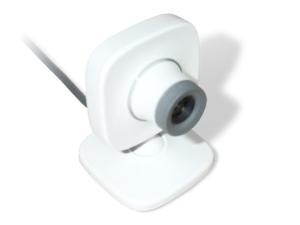Xbox Live Vision
 |
|

Xbox Live Vision camera
|
|
| Developer | Microsoft |
|---|---|
| Manufacturer | Microsoft |
| Product family | Xbox |
| Type | Gaming Webcam |
| Generation | Seventh generation era |
| Camera | |
| Connectivity | USB 2.0 type-A |
| Platform |
|
| Dimensions | 45 mm × 45 mm × 60 mm (1.8 in × 1.8 in × 2.4 in) |
| Successor | Kinect |
| Related articles | PlayStation Eye, EyeToy, Kinect, Xbox 360 accessories |
Xbox Live Vision is a webcam accessory that was developed as an accessory for the Xbox 360 video game console. It was announced at E3 2006 and was released in North America on September 19, 2006, Europe and Asia on October 2, 2006, and Japan on November 2, 2006.
In 2010, Xbox Live Vision was succeeded by Kinect, a new camera accessory that also incorporates a motion tracking system and adds voice recognition functionality to the console.
The camera can be used for video chat, personalized gamer pictures, in-game video chat, and still pictures. The camera features 640 × 480 video at 30 fps and is capable of taking still images at 1.3 megapixels. It allows for video chat and picture messages (requires Xbox Live Gold) with video effects along with in-game compatibility. Certain games allow a digital zoom of 2x or 4x while video chatting.
It also features three camera effects, in which the currently captured video image is overlaid on the dashboard background. The three effects are 'watery', 'edgy', and 'dotty'. The camera uses a standard USB 2.0 connection and is also Windows (XP and newer) and Mac OS X (v10.4.9 and newer) compatible.
The Xbox Live Vision Camera was announced at E3 2006 and released in North America on September 19, 2006, following a 1-month pre-launch period in which Toys "R" Us stores in New York City and Los Angeles sold them to build up hype. It was released in Europe and Asia on October 6, 2006, and November 2, 2006 in Japan.
Using its USB 2.0 connection, the Vision Camera is compatible with Windows XP Service Pack 2 (32-bit only), Windows Vista (32-bit and 64-bit), and Windows 7 (32-bit and 64-bit, although 64-bit is not confirmed by Microsoft). Because the Vision Camera lacks audio input, a microphone must also be connected to the computer for voice chat and audio recording. Drivers are not included with the Vision Camera but can be downloaded automatically by Windows when prompted. One restriction of the Vision cam when used on the Windows is that it will not natively record videos, only take pictures. Additional software may be used to alleviate this problem.
...
Wikipedia
